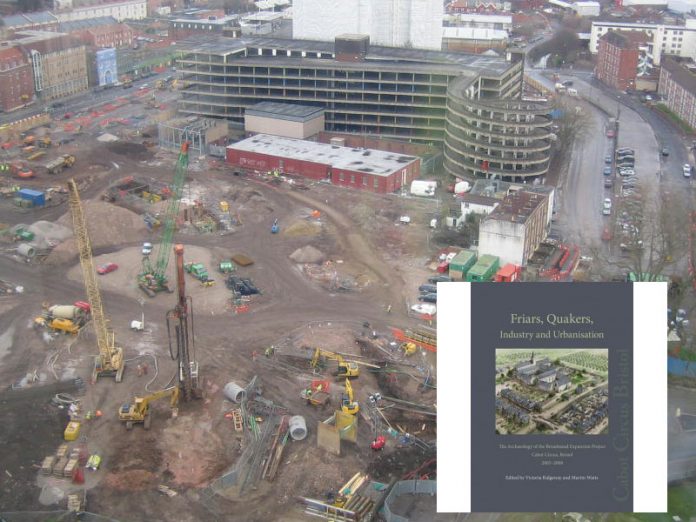The development of Cabot Circus shopping centre presented a rare opportunity for archaeological investigation of a large part of the Broadmead suburb of Bristol. Late in 2005 Cotswold Archaeology and Pre-Construct Archaeology (a consortium of archaeological practices collectively known as CAPCA) commenced a programme of archaeological work and this new volume brings together the project’s exciting discoveries, covering everything from evidence for the prehistoric landscape to elements of a Dominican friary and later Friends’ Meeting House (structural remains of which survive as scheduled buildings preserved within a large open piazza in the west of the new development).
The former presence of a Dominican Friary and later Friends’ Meeting House were already well known, and surviving buildings from both remain within a large open piazza in the west of the new development.
Further elements of the friary complex, including remains of the church and two cloisters, were revealed in various archaeological interventions within the area of the former precinct, enabling a reconstruction of the precinct and its environs to be made.
The project has shed light on other aspects of the suburb’s past that were previously less well known. Borehole investigations have allowed the prehistoric environment of the River Frome valley to be characterised, with episodes of small-scale tree clearance from the surrounding slopes during the later Neolithic and early Bronze Age, and the floodplain remaining as mud flats until the development of the Broadmead suburb in the 12th century and the arrival of the Dominicans in the 13th century. River access and the presence of flowing water were important assets for the industrial medieval and later suburb, which was home to tanning, leatherworking, ironworking and cloth industries. The Dissolution saw the demolition of parts of the friary, and by the later 17th century the surviving claustral buildings were occupied by trade guilds and the Quakers had built their first Meeting House.
The 18th and 19th centuries were times of enormous expansion for Bristol, when large-scale development occurred, expanding the suburb to the north and east of the former friary. These new developments included industrial premises, saw mills, cabinet works and malthouses, alongside terraces and courts of domestic dwellings. The recovery of a significant assemblage of tobacco pipe bowls and kiln wasters has enabled the development of new typology for Bristol, which should prove invaluable in dating future assemblages recovered from the city.
You can buy the book from Oxbow here:
Victoria Ridgeway (Editor); Martin Watts (Editor)
ISBN: 9780956305480 | Published by: Cotswold Archaeology | Series: CA monograph/PCA monograph | Volume: 5/16 | Year of Publication: 2013 | Language: English 450p, colour 107; B&W 116
£34.95
http://www.oxbowbooks.com/oxbow/friars-quakers-industry-and-urbanisation.html


